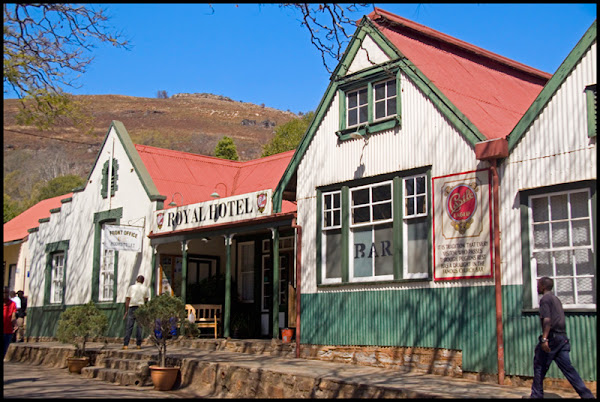Etapas del viaje / Trip sections:
El día 25 dejábamos atras el Parque Nacional Kruger para dirigirnos hacia el aeropuerto de Johannesburgo de donde saldríamos el día 26 por la tarde. El trayecto hasta el aeropuerto era de bastantes horas, así que decidimos pasar la noche del día 25 en Graskop y aprovechar la jornada para hacer un poco de turismo más convencional, vistiando principalmente la Blyde River Canyon Nature Reserve y zonas cercanas, incluida la Berlin Falls, donde encontré algunos ibis calvos. Al día siguiente, el 26, paramos a visitar, por la mañana, el antiguo pueblo minero de Pilgrim's Rest, un bonito contrapunto al resto del viaje. En todas las paradas hice pocas observaciones, dado el poco tiempo que estuvimos en cada una. Antes de partir, en Punda Maria Camp, nos dio tiempo de ver una cubla dorsiengra.
On August 25th we left the Kruger National Park to head towards the Johannesburg airport where we would depart on the 26th afternoon. The journey to the airport was quite long, so we decided to spend the night of 25th in Graskop. During that day we did some conventional tourism. We visited several spots within the Blyde River Canyon Nature Reserve and nearby areas, including the Berlin Falls, where I found some bald ibis. The next day, the 26th, we visited, during the morning, the old mining town of Pilgrim's Rest, a nice counterpoint to the rest of our trip. I only managed to do few observations at every stop, given the short time we spent at each one. Before leaving, we had time to see, at Punda Maria Camp, a black-backed puffback.
La crónica completa del viaje en eBird, incluyendo el mapa y la lista de aves observadas, se puede obtener pinchando en este enlace.
The complete eBird trip report, including map and the list of bird species can be seen in this link.
1. Abel Erasmus Pass-Strijdom Tunnel.
La primera parada fue en el Abel Erasmus Pass, un punto muy conocido para ver halcón taita. Allí hay un guía, Mukil Kumako, que por una módica propina se ofrece a localizarlo. Tras una confusión inicial, no hubo manera, aunque vimos un halcón peregrino.
The first stop was at the Abel Erasmus Pass, a well-known spot to see taita falcon. There is a bird guide there, named Mukil Kumako, who offers to locate the bird for you (obviously, you have to give him an small tip). After an initial confusion, there was no way, although we did see a peregrine falcon.
La lista completa de especies observadas y su localización puede encontrarse en este enlace.
The complete list of species observed and its location can be seen in this link.
2. Blyde River Canyon NR-Three Rondavels Lookout.
La segunda parada fue en el Three Rondavels Lookout, que ofrece unas vistas espectaculares del cañón formado por el Blyde River.
The second stop was at the Three Rondavels Lookout, that offers spectacular views of the canyon formed by the Blyde River.
La lista completa de especies observadas y su localización puede encontrarse en este enlace.
The complete list of species observed and its location can be seen in this link.
3. Blyde River Canyon NR-Bourkes Luck Potholes.
En el Bourkes Luck Potholes aprovechamos para comer (cuenta con un pequeño restaurante). Aunque había bastante gente, aquí disfruté de un zorzal litsitsirupa.
At Bourkes Luck Potholes we stopped to have lunch (it has an small restaurant). Although it was crowded, I managed to see a groundscraper thrush.
La lista completa de especies observadas y su localización puede encontrarse en este enlace.
The complete list of species observed and its location can be seen in this link.
4. Berlin Falls.
Merece la pena visitar la Berlin Falls, donde habita una pequeña colonia de ibis calvo. Además, pude ver, por los alrededores, algún papión chacma.
It is interesting to stop at Berlin Falls, where there is an small breeding colony of southern bald ibis. I also could see, in the surroundings, some chacma baboon.
5. Blyde River Canyon NR-God's Window-Rainforest trail.
Al God's Window llegamos al caer el sol, pero aún así me pareció un punto interesante para ver algunas especies más. Allí vi por primera vez el batis de El Cabo.
We arrived at God's Window at sunset, but it still seemed like an interesting spot to see some more species. There, I saw my first Cape Batis.
La lista completa de especies observadas y su localización puede encontrarse en este enlace.
The complete list of species observed and its location can be seen in this link.
6. Pilgrim's Rest.
La fiebre del oro creó este bonito pueblo que conserva la apariencia que debió tener hacia finales del siglo XIX. Sin duda, una visita interesante para terminar nuestro viaje a Sudáfrica.
The gold rush was the origin of this beautiful town that retains the appearance it had at the end of the XIX century. Without a doubt, an interesting visit to finish our trip to South Africa.
















